
The Bromeliaceae are a family of monocot flowering plants of about 80 genera and 3700 known species, native mainly to the tropical Americas, with several species found in the American subtropics and one in tropical west Africa, Pitcairnia feliciana.
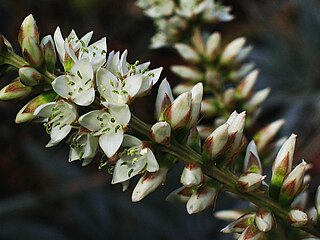
Hechtia is a genus of plants in the family Bromeliaceae, and is the sole genus of the subfamily Hechtioideae, containing 75 species. Its species are native to Mexico, Central America, and Texas.

Pitcairnioideae is a subfamily of the bromeliad family, Bromeliaceae. Traditionally, it was a large subfamily, comprising all those species with winged or more rarely naked seeds. Molecular phylogenetic studies showed that traditional Pitcairnioideae was not monophyletic, and the subfamily was more narrowly circumscribed. As of November 2022, the Encyclopaedia of Bromeliads placed five genera in the subfamily. Members of the subfamily are found from the Andes to the coast of Brazil, with one genus (Fosterella) found northwards to Mexico.
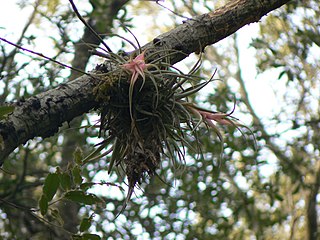
Tillandsia erubescens is a species of epiphytic plants of the genus Tillandsia. This species is endemic to Mexico, found over much of the country from Chihuahua to Oaxaca.
Tillandsia violacea is a species of epiphytic flowering plant in the family Bromeliaceae. It is endemic to Mexico, particularly to the Central Mexican Plateau. This species' habitat is at elevations between 600 and 3,100 meters, and is epiphytic to large trees in humid temperate forests, primarily the species Abies religiosa, Quercus rugosa, and Quercus laurina. In particular, it is a common epiphyte of the temperate pine forests of Hidalgo state, including El Chico National Park. Its range extends to the states of Guerrero, Jalisco, state of Mexico, Michoacán, Morelos, Oaxaca, and Veracruz. Due to its high-elevation habitat, this bromeliad species has tolerance to sub-freezing conditions.

Tillandsia juncea is a species of flowering plant in the genus Tillandsia. This species is native to northern South America, Central America, Mexico and the West Indies.

Tillandsia polystachia is a species of flowering plant in the genus Tillandsia. This species is native to Central America, the West Indies, Bolivia, Colombia, Brazil, Ecuador, Mexico and Venezuela.
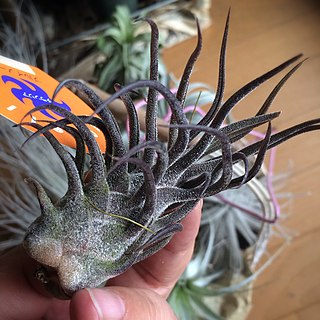
Tillandsia pruinosa, is a species of flowering plant in the family Bromeliaceae. It is commonly known as the fuzzywuzzy airplant. This species is native to northern South America, Central America, southern Mexico, the West Indies and Florida.
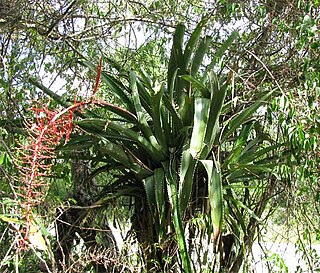
Aechmea bracteata is a plant species in the genus Aechmea. This species is native to Central America, Mexico, Colombia, and Venezuela; it is also reportedly naturalized in the Bahamas.

Aechmea lueddemanniana is a species in the genus Aechmea. This species is native to Costa Rica, Guatemala, Belize, Honduras, Nicaragua and southern Mexico as far north as Veracruz.
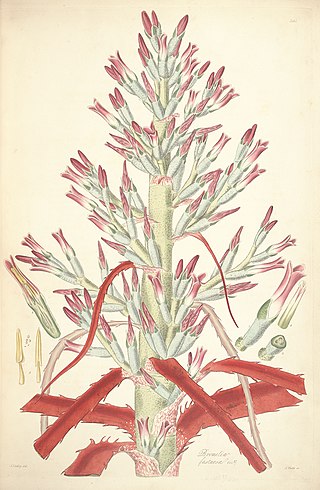
Bromelia pinguin is a plant species in the genus Bromelia. This species is native to Central America, Mexico, the West Indies and northern South America. It is also reportedly naturalized in Florida. It is very common in Jamaica, where it is planted as a fence around pasture lands, on account of its prickly leaves. The plant can be stripped of its pulp, soaked in water, and beaten with a wooden mallet, and it yields a fiber whence thread is made. In Nicaragua and El Salvador it is used to make gruel.
Catopsis paniculata is a species in the genus Catopsis. This species is native to Central America and Mexico.
Catopsis wangerinii is a species in the genus Catopsis. This species is native to Central America, Colombia, and Mexico.

Pitcairnia heterophylla is a plant species in the genus Pitcairnia. This species is native to northern South America, Central America, and central and southern Mexico.

Tillandsia fasciculata, commonly known as the giant airplant, giant wild pine, or cardinal airplant, is a species of bromeliad that is native to Central America, Mexico, the West Indies, northern South America, and the southeastern United States. Within the United States, this airplant is at risk of extirpation from the Mexican bromeliad weevil, Metamasius callizona. A related plant, Tillandsia utriculata, sometimes called the "wild pine", is endemic to the same areas.
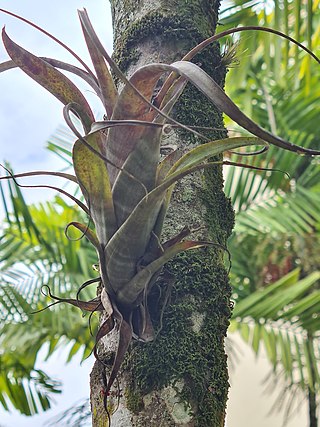
Tillandsia flexuosa, the twisted airplant, is a species of bromeliad in the genus Tillandsia. This species is native to Central America, southeastern Mexico, northern South America and the United States (Florida).
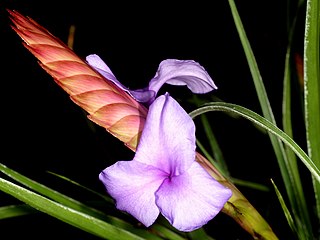
Tillandsia guatemalensis is a species of flowering plant in the genus Tillandsia. This species is native to Mexico and Central America.

Tillandsia ionantha, the air plant, is a species of plant in the genus Tillandsia. This species is native to Central America and Mexico. It is also reportedly naturalized in Broward County, Florida.

Tillandsia utriculata, commonly known as the spreading airplant, the giant airplant, or wild pine is a species of bromeliad that is native to Florida and Georgia in the United States, the Caribbean, southern and eastern Mexico, Central America, and Venezuela.

Werauhia gladioliflora is a plant species in the genus Werauhia. This species is native to Bolivia, Costa Rica, Mexico, Venezuela and Ecuador.
















